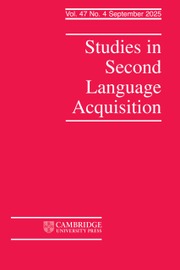Crossref Citations
This article has been cited by the following publications. This list is generated based on data provided by
Crossref.
Peters, Elke
2018.
The effect of out-of-class exposure to English language media on learners’ vocabulary knowledge.
ITL - International Journal of Applied Linguistics,
Vol. 169,
Issue. 1,
p.
142.
Rodgers, Michael P. H.
2018.
The images in television programs and the potential for learning unknown words.
ITL - International Journal of Applied Linguistics,
Vol. 169,
Issue. 1,
p.
191.
Vanderplank, Robert
2019.
The Handbook of Informal Language Learning.
p.
181.
Dubiner, Deborah
2019.
Second language learning and teaching: From theory to a practical checklist.
TESOL Journal,
Vol. 10,
Issue. 2,
Sundqvist, Pia
2019.
The Handbook of Informal Language Learning.
p.
319.
Peters, Elke
Noreillie, Ann‐Sophie
Heylen, Kris
Bulté, Bram
and
Desmet, Piet
2019.
The Impact of Instruction and Out‐of‐School Exposure to Foreign Language Input on Learners’ Vocabulary Knowledge in Two Languages.
Language Learning,
Vol. 69,
Issue. 3,
p.
747.
Peters, Elke
2019.
The Effect of Imagery and On‐Screen Text on Foreign Language Vocabulary Learning From Audiovisual Input.
TESOL Quarterly,
Vol. 53,
Issue. 4,
p.
1008.
Perez, Maribel Montero
and
Rodgers, Michael P. H.
2019.
Video and language learning.
The Language Learning Journal,
Vol. 47,
Issue. 4,
p.
403.
Suárez, Maria del Mar
and
Gesa, Ferran
2019.
Learning vocabulary with the support of sustained exposure to captioned video: do proficiency and aptitude make a difference?.
The Language Learning Journal,
Vol. 47,
Issue. 4,
p.
497.
Puimège, Eva
and
Peters, Elke
2019.
Learners’ English Vocabulary Knowledge Prior to Formal Instruction: The Role of Learner‐Related and Word‐Related Variables.
Language Learning,
Vol. 69,
Issue. 4,
p.
943.
Sierocka, Halina
Jurković, Violeta
and
Varga, Mirna
2019.
The Role of Smartphones for Online Language Use in the Context of Polish and Croatian Students of Different Disciplines.
Studies in Logic, Grammar and Rhetoric,
Vol. 58,
Issue. 1,
p.
173.
Puimège, Eva
and
Peters, Elke
2019.
Learning L2 vocabulary from audiovisual input: an exploratory study into incidental learning of single words and formulaic sequences.
The Language Learning Journal,
Vol. 47,
Issue. 4,
p.
424.
Uchihara, Takumi
Webb, Stuart
and
Yanagisawa, Akifumi
2019.
The Effects of Repetition on Incidental Vocabulary Learning: A Meta‐Analysis of Correlational Studies.
Language Learning,
Vol. 69,
Issue. 3,
p.
559.
Montero Perez, Maribel
2019.
Pre-learning vocabulary before viewing captioned video: an eye-tracking study.
The Language Learning Journal,
Vol. 47,
Issue. 4,
p.
460.
Durbahn, Marion
Rodgers, Michael
and
Peters, Elke
2020.
The relationship between vocabulary and viewing comprehension.
System,
Vol. 88,
Issue. ,
p.
102166.
Montero Perez, Maribel
2020.
INCIDENTAL VOCABULARY LEARNING THROUGH VIEWING VIDEO.
Studies in Second Language Acquisition,
Vol. 42,
Issue. 4,
p.
749.
Wisniewska, Natalia
and
Mora, Joan C.
2020.
CAN CAPTIONED VIDEO BENEFIT SECOND LANGUAGE PRONUNCIATION?.
Studies in Second Language Acquisition,
Vol. 42,
Issue. 3,
p.
599.
Rodgers, Michael P. H.
and
Webb, Stuart
2020.
Incidental vocabulary learning through viewing television.
ITL - International Journal of Applied Linguistics,
Vol. 171,
Issue. 2,
p.
191.
Sinyashina, Ekaterina
2020.
‘Incidental + Intentional’ vs ‘Intentional + Incidental’ Vocabulary Learning: Which is More Effective?.
Complutense Journal of English Studies,
Vol. 28,
Issue. ,
p.
93.
González Ortega, Bianca
and
Mañas Navarrete, Iban
2020.
Efectos de los subtítulos intralingüísticos y los subtítulos bilingües aumentados sobre el aprendizaje incidental de vocabulario en español como lengua extranjera.
RILEX. Revista sobre investigaciones léxicas,
Vol. 3,
Issue. 2,
p.
125.
Open materials

